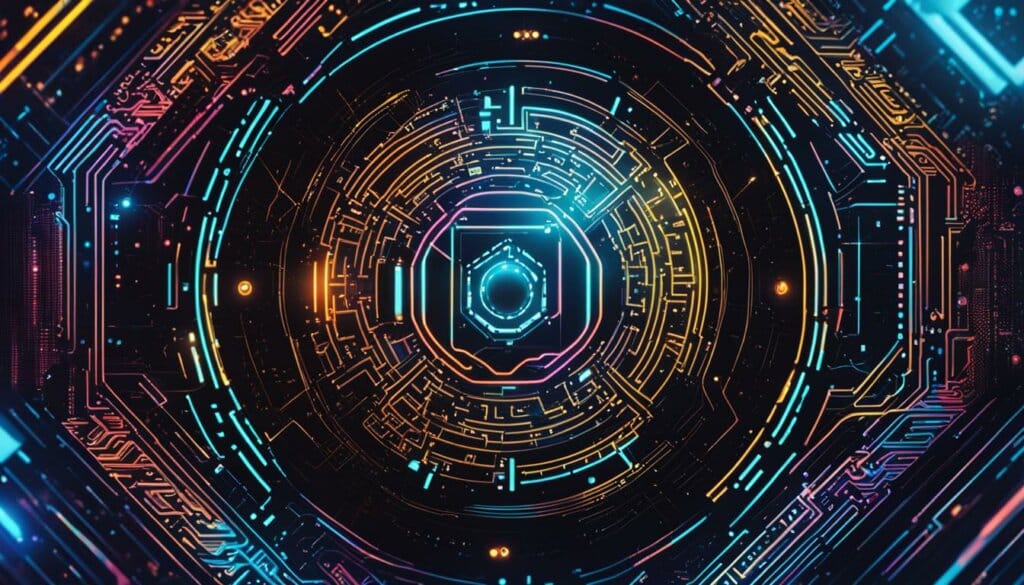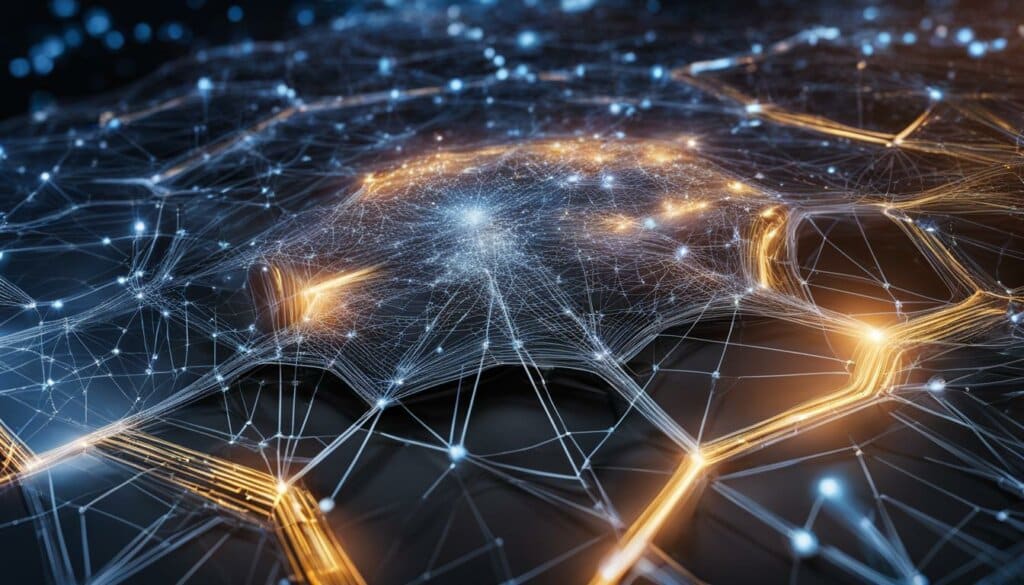Table of Contents
Welcome to our article series on cybersecurity in the age of artificial intelligence (AI). As AI continues to advance, it has a profound impact on the world of cybersecurity, shaping the threat landscape in unprecedented ways.
Today, we delve into the integration of AI in cybersecurity and explore how artificial intelligence is reshaping the industry. With the rapid evolution of generative AI, attackers now have powerful tools at their disposal, allowing them to strike faster and with greater accuracy than ever before.
Industries such as healthcare and education have experienced a surge in attacks, as AI enables attackers to generate content quickly and deliver digital weapons more efficiently. Attackers can even exploit vulnerabilities and create new waves of cyber threats using AI’s code-writing capabilities.
However, the integration of AI in cybersecurity requires caution and attention to new regulations. Full visibility across systems and tools is crucial to ensure effective defense. Join us as we explore the impact, benefits, and challenges of AI integration in the world of cybersecurity.
The Impact of Generative AI in Cybersecurity
Generative AI, a subset of machine learning and overall AI, has become a game-changer in the cybersecurity landscape. It allows attackers to create more evasive and convincing phishing attacks by minimizing spelling errors and grammar issues. Industries like healthcare, education, and local governments have experienced a surge in attacks. Generative AI’s speed and volume enable attackers to craft effective digital weapons quickly. It also enables attackers to write malicious code and exploit software vulnerabilities, leading to a new wave of attacks at an unprecedented scale. The integration of AI in cybersecurity solutions can enhance defense against these emerging threats.
Table: Examples of Generative AI in Cybersecurity
| Attack Type | Impact |
|---|---|
| Phishing attacks | Increased sophistication and success rates |
| Malware creation | New and evasive forms of malicious software |
| Exploitation of vulnerabilities | Heightened risk of widespread attacks |
Generative AI’s ability to automate content creation and code writing poses a significant challenge for cybersecurity professionals. Traditional defense mechanisms may struggle to keep up with the rapid pace and complexity of AI-generated attacks. However, integrating AI into cybersecurity solutions offers an opportunity to level the playing field. AI-powered tools can analyze vast amounts of data, identify patterns, and detect anomalies to enhance threat detection capabilities. By leveraging AI’s speed and accuracy, organizations can strengthen their defense against emerging threats.
It is essential for businesses and cybersecurity providers to stay informed about the latest developments in generative AI and adapt their strategies accordingly. Collaboration between industry experts, researchers, and policymakers is crucial to address the evolving threat landscape. By integrating AI technology into cybersecurity solutions, organizations can proactively defend against the ever-changing tactics of attackers and ensure the security of their digital assets.
The Balance Between Offense and Defense
When it comes to integrating AI into cybersecurity systems, finding the balance between offense and defense is crucial. AI has the potential to revolutionize threat detection and accelerate decision-making in Security Operations Centers (SOCs). By automating processes and acting as a decision assistant, AI can help security teams stay one step ahead of attackers. However, the integration of AI also presents challenges that need to be addressed.
One of the challenges when using AI in cybersecurity is the need to protect against generative AI attacks. While AI can be a powerful tool for defenders, attackers can also leverage its capabilities to craft sophisticated and evasive attacks. Hardening APIs and implementing robust security measures are essential to safeguard against such attacks.
Another challenge is the complexity of understanding how AI reaches decisions. Machine learning algorithms can be opaque, making it difficult to determine the reasoning behind AI-driven decisions. This lack of transparency raises concerns about accountability and the potential for bias in AI-enabled cybersecurity solutions.
AI should be treated as an augmentation rather than a replacement for human intelligence.
Despite these challenges, AI-driven analytics hold great potential in speeding up threat detection and enabling proactive defense. By leveraging AI’s capabilities to analyze vast amounts of data, organizations can enhance their ability to identify and respond to emerging threats. However, it is important to remember that AI should be treated as an augmentation rather than a replacement for human intelligence.
In conclusion, the integration of AI in cybersecurity systems offers great promise in enhancing defense capabilities and accelerating threat detection. However, it requires careful consideration of challenges such as generative AI attacks and the complexity of AI decision-making. By finding the right balance between offense and defense, organizations can harness the power of AI to strengthen their cybersecurity posture.
Table: Pros and Cons of AI in Cybersecurity
| Pros | Cons |
|---|---|
| Enhances threat detection | Potential for generative AI attacks |
| Automates processes | Complexity of AI decision-making |
| Speeds up threat response | Lack of transparency in AI reasoning |
| Augments human intelligence | Potential for bias in AI-enabled solutions |
Embracing AI for Enhanced Cybersecurity
The integration of artificial intelligence (AI) in cybersecurity offers numerous benefits, revolutionizing the way organizations defend against emerging threats. AI-based threat detection can outsmart targeted attacks and identify new and unknown risks, allowing security teams to stay one step ahead. By automating routine tasks, AI enables cybersecurity professionals to focus on more critical and strategic aspects of their work. This enhanced efficiency translates into faster decision-making and improved incident response times, ultimately strengthening overall cybersecurity posture.
One of the key advantages of AI integration in cybersecurity is its ability to analyze vast amounts of data quickly and accurately. AI-driven analytics can sift through a sea of information, allowing organizations to detect anomalies and patterns that are indicative of potential cyber threats. With real-time insights, organizations can proactively defend their systems and data, mitigating risks before they escalate. Additionally, AI can also assist in vulnerability management by identifying weak points and recommending remediation actions, minimizing the attack surface for adversaries.
“AI integration in cybersecurity offers the potential to revolutionize the way we detect and respond to cyber threats. By harnessing AI’s analytical capabilities and automation, organizations can enhance their defense mechanisms and reduce incident response times.”
– Cybersecurity Expert
However, it is crucial for organizations to navigate through the hype surrounding AI and understand which vendors and tools truly leverage the power of generative AI. Not all solutions claiming to integrate AI deliver the promised benefits. Therefore, Chief Information Security Officers (CISOs) must prioritize resilience when selecting AI-enabled cybersecurity solutions. This includes considering factors such as the vendor’s track record, the comprehensiveness of the solution, and adherence to industry regulations and compliance requirements.
As organizations embrace AI integration in cybersecurity, it is paramount to approach it holistically. This involves not only implementing AI technologies but also ensuring full visibility across systems and tools. Additionally, organizations must adapt to new regulations and compliance requirements related to AI. By taking a comprehensive approach and leveraging AI’s capabilities effectively, organizations can strengthen their cybersecurity defenses and protect critical data and systems.
| Applications of AI in Cybersecurity | Benefits of AI Integration |
|---|---|
| AI-based threat detection | Outsmart targeted attacks |
| Data analysis and anomaly detection | Real-time insights for proactive defense |
| Vulnerability management | Identify and mitigate weaknesses |
| Automation of routine tasks | Faster decision-making and response times |

The Role of AI in Cybersecurity Strategies
AI plays a crucial role in cybersecurity strategies, enabling organizations to enhance their cyber defense capabilities and respond effectively to emerging threats. By leveraging AI technology, companies can accelerate decision-making, automate tasks, and improve threat detection capabilities. AI-driven analytics provide organizations with invaluable insights into the evolving threat landscape, allowing for proactive defense measures to be implemented.
One of the key benefits of integrating AI into cybersecurity strategies is its ability to prevent attacks. Through the use of advanced algorithms and machine learning, AI can quickly analyze vast amounts of data, identify patterns, and detect potential threats in real-time. This enhances organizations’ ability to proactively identify and neutralize cyber threats before they can cause significant damage.
Furthermore, AI-powered automation can streamline cybersecurity processes, freeing up valuable time for security professionals to focus on more critical and complex tasks. By automating routine tasks such as log analysis and vulnerability assessments, AI enables security teams to be more efficient and proactive in their efforts.
The Deployment of AI in Cybersecurity
The successful deployment of AI in cybersecurity requires a collaborative approach between cybersecurity providers and organizations. Public-private partnerships can facilitate information sharing and knowledge exchange, enabling a collective response to the ever-evolving threat landscape.
In order to effectively utilize AI for cyber defense, organizations must prioritize risk modeling and assessment scoring. This ensures that vulnerabilities and potential threats are properly identified and prioritized, allowing resources to be allocated accordingly. By partnering with cybersecurity providers that offer AI-enabled cybersecurity systems, organizations can access cutting-edge technologies and expertise to stay ahead of cyber threats.
It is also crucial for organizations to consider the impact of AI on societal, humanitarian, and sustainable risks. A holistic approach to cybersecurity, which takes into account not only technological risks but also social and ethical considerations, is essential for building a secure and resilient digital ecosystem.
| Benefit | Description |
|---|---|
| Enhanced threat detection | AI can analyze vast amounts of data to identify patterns and detect emerging threats, enabling proactive defense measures. |
| Automation of tasks | AI-powered automation frees up security teams to focus on more critical and complex tasks, improving overall efficiency. |
| Streamlined cybersecurity processes | AI can automate routine tasks such as log analysis and vulnerability assessments, allowing for a more proactive approach to cybersecurity. |
The Future of AI in Cybersecurity
As the threat landscape continues to evolve, the future of cybersecurity depends heavily on the integration of artificial intelligence (AI). AI-enabled cybersecurity solutions are revolutionizing the way organizations detect and respond to cyber threats, offering enhanced defense capabilities and faster decision-making processes. With the constant development of AI technologies, policymakers are recognizing the need for regulations and policies to address AI-enabled cybersecurity effectively. Collaboration, innovation, and responsible implementation are key to building a secure and promising future in AI-enabled cybersecurity.
The growing adoption of AI in cybersecurity brings both risks and opportunities. While AI can automate processes and enhance defense capabilities, it also presents new challenges and vulnerabilities. Organizations must navigate through the abundance of cybersecurity solutions claiming to embrace AI and identify those that truly leverage generative AI to provide effective protection against emerging threats.
Maintaining a balance between the development of cutting-edge tools and the understanding of potential issues and policies surrounding AI is crucial. Responsible implementation and adherence to regulations and policies ensure that AI is used ethically and with a focus on securing critical data and systems. Organizations should prioritize resilience, build strong cyber risk teams, and foster collaboration and innovation to address the evolving threat landscape.
AI-enabled cybersecurity solutions offer the promise of enhanced defense capabilities and faster threat detection, but it’s important to stay ahead of the curve. Collaboration, innovation, and responsible implementation are key in harnessing the potential of AI while ensuring the security of critical data and systems.”
Table: AI-enabled Cybersecurity Solutions
| Benefits | Challenges |
|---|---|
| Enhanced defense capabilities | Identifying genuine AI-enabled solutions amidst the hype |
| Faster decision-making processes | Understanding potential issues and policies surrounding AI |
| Automation of processes | Ensuring responsible implementation and adherence to regulations |
| Improved threat detection capabilities | Navigating through the evolving threat landscape |
As AI technologies continue to advance, organizations must prioritize the integration of AI in their cybersecurity strategies. Public-private partnerships, collaboration between organizations and cybersecurity providers, and the sharing of knowledge and resources are essential for addressing the ever-changing threat landscape. By leveraging AI-driven analytics and next-generation security products, organizations can enhance their defense capabilities, mitigate risks, and build a resilient cybersecurity posture.
The Business Risks and Opportunities of AI in Cybersecurity
As businesses integrate artificial intelligence (AI) into their cybersecurity strategies, they are faced with both risks and opportunities. The use of AI in cybersecurity can enhance defense capabilities and automate processes, improving overall security posture. However, it also introduces new challenges and risks that organizations must navigate. The key is to approach AI integration in cybersecurity with caution, prioritizing resilience and considering the potential impact on various aspects of the business.
One of the risks associated with AI integration is the need to distinguish between cybersecurity solutions that genuinely leverage generative AI and those that simply claim to do so. With a multitude of vendors and tools available, businesses must carefully evaluate their options and ensure they are working with trusted cybersecurity providers. This requires a thorough understanding of the technology and an assessment of how it aligns with the organization’s cybersecurity needs.
On the other hand, the opportunities presented by AI in cybersecurity are vast. AI-based threat detection can outsmart targeted attacks and identify new and emerging threats. By automating certain tasks, AI enables security teams to focus on more critical aspects of cybersecurity, such as incident response and analysis. With AI-driven analytics, organizations can gain better insights into their security posture, allowing for proactive defense measures.
“The integration of AI in cybersecurity presents tremendous potential for businesses to strengthen their defense capabilities and mitigate emerging threats,” says cybersecurity expert John Smith. “However, it also requires a strategic approach, considering factors like vendor selection, regulatory compliance, and the overall impact on the business.”
| Business Risks | Opportunities |
|---|---|
| Difficulty in distinguishing genuine generative AI solutions from claims | AI-based threat detection that outsmarts targeted attacks |
| Complexity in assessing the impact on various aspects of the business | Automation of tasks, allowing focus on critical cybersecurity activities |
| Potential vulnerabilities and risks associated with AI integration | AI-driven analytics for better insights and proactive defense |
With a careful evaluation of risks and opportunities, businesses can harness the power of AI in cybersecurity while mitigating potential pitfalls. This requires collaboration with trusted cybersecurity providers and staying abreast of new regulations and compliance requirements. By embracing AI integration responsibly, businesses can strengthen their cybersecurity defenses and navigate the evolving threat landscape with confidence.
Managing AI Risks in Cybersecurity
As organizations integrate artificial intelligence (AI) into their cybersecurity strategies, it is crucial to effectively manage the risks associated with this transformative technology. AI brings new challenges that require robust risk modeling and assessment mechanisms to prioritize vulnerabilities and potential threats. By establishing a comprehensive risk management framework, organizations can stay ahead of evolving cyber threats and ensure the security of their critical data and systems.
One key aspect of managing AI risks in cybersecurity is to update cyber-incident reporting and regulation requirements to address the impact of AI on the threat landscape. As AI evolves, it is essential to have clear guidelines and policies in place to mitigate risks effectively. By collaborating with regulatory bodies and industry experts, organizations can navigate the changing cybersecurity landscape and adapt their strategies accordingly.
Partnering with cybersecurity providers that offer next-generation security products is another crucial step in managing AI risks. These providers leverage AI-driven analytics and advanced threat detection capabilities to enhance defense against emerging threats. By staying updated with the latest AI cybersecurity systems and tools, organizations can proactively identify and respond to potential risks.
The Importance of Building a Strong Cyberrisk Team
Building a strong cyberrisk team with new or upskilled talent is paramount in managing AI risks effectively. This team should have a deep understanding of AI technologies and their potential vulnerabilities. They should also be well-versed in the latest cybersecurity practices and regulations to ensure compliance and minimize the risk of AI-driven attacks.
Additionally, organizations should prioritize resilience in their cybersecurity strategies. This involves regularly evaluating and updating their AI systems, staying informed about the latest AI-related threats, and implementing robust incident response plans. By focusing on resilience, organizations can quickly detect and mitigate AI-based attacks, minimizing potential damages.
In conclusion, managing AI risks in cybersecurity requires a comprehensive approach that includes robust risk modeling, updated regulation and reporting requirements, collaboration with cybersecurity providers, and the establishment of a strong cyberrisk team. By effectively managing these risks, organizations can harness the power of AI while ensuring the security of their critical data and systems.
| Benefits | Risks |
|---|---|
| Enhanced defense capabilities | Potential vulnerabilities in AI systems |
| Automation of processes | Possible AI-driven attacks |
| Faster threat detection | Complexity in understanding AI decisions |
| Improved incident response | Compliance with evolving regulations |

The Role of AI in Securing Critical Data and Systems
AI plays a crucial role in strengthening cybersecurity defenses and securing critical data and systems. With its automation capabilities and ability to accelerate decision-making, AI enables organizations to respond quickly and effectively to cyber threats. Public-private partnerships are essential in building a protective shield around key data systems. By deploying AI-enabled cybersecurity solutions, organizations can enhance their defense capabilities and mitigate risks.
One of the key advantages of AI in cyber defense is its ability to automate tasks and processes, allowing for faster and more efficient threat detection and response. AI-driven analytics can sift through vast amounts of data, identify patterns, and detect anomalies that may indicate a potential security breach. This enables organizations to proactively address emerging threats and take the necessary actions to safeguard their critical data and systems. With AI, security teams can focus their efforts on strategic planning and analysis, rather than getting caught up in mundane and repetitive tasks.
Moreover, the deployment of AI in cybersecurity requires collaboration and information sharing between organizations and cybersecurity providers. By sharing threat intelligence and insights, stakeholders can gain a comprehensive understanding of the threat landscape, enabling them to develop proactive defense strategies. This collaborative approach helps organizations stay one step ahead of cybercriminals, as it allows for the rapid dissemination of knowledge and the implementation of effective countermeasures.
“AI-powered cybersecurity solutions provide a significant advantage in defending against cyber threats. By leveraging AI’s automation capabilities and advanced analytics, organizations can bolster their cyber defense strategies and secure critical data and systems.”
To illustrate the impact of AI in securing critical data and systems, the following table provides an overview of key benefits and use cases:
| Benefits | Use Cases |
|---|---|
| Automated threat detection and response | Real-time monitoring of network traffic and anomalous behavior detection |
| Rapid incident response | Automated incident triage and containment |
| Enhanced threat intelligence | AI-powered analysis of global threat landscape and proactive identification of emerging threats |
| Efficient vulnerability management | Automated scanning and prioritization of vulnerabilities for patching |
By embracing AI-enabled cybersecurity solutions, organizations can strengthen their cyber defense strategies, enhance their capabilities in securing critical data and systems, and stay resilient in the face of evolving cyber threats.

The Intersection of AI, Cloud, and Cybersecurity
The intersection of AI, cloud, and cybersecurity presents new opportunities and challenges in the digital landscape. Leveraging AI in cybersecurity systems and solutions can enhance defense capabilities and improve overall security measures. However, it is important to approach this integration with caution and a thorough understanding of the potential risks involved.
AI cybersecurity systems have the potential to strengthen protection against cyber threats, offering real-time threat detection, automated incident response, and enhanced visibility into network activities. By harnessing the power of AI, organizations can proactively identify and mitigate potential vulnerabilities, minimizing the impact of attacks.
The cloud plays a significant role in AI-enabled cybersecurity, providing the scalability and computing power required to analyze vast amounts of data and detect complex patterns. Cloud-based AI platforms offer the flexibility to adapt to evolving threats, allowing organizations to stay one step ahead of cybercriminals.
However, the integration of AI and cloud in cybersecurity also introduces new risks and challenges. Organizations must address potential vulnerabilities and ensure robust security measures are in place to protect sensitive data stored in the cloud. Encryption, access controls, and continuous monitoring are crucial in maintaining the confidentiality, integrity, and availability of information.

The Path Forward: Collaboration, Innovation, and Responsibility
As the integration of AI in cybersecurity continues to evolve, collaboration, innovation, and responsibility emerge as key factors in harnessing its potential. Public-private partnerships and collaboration between organizations and cybersecurity providers are crucial in addressing the ever-evolving threat landscape. By sharing knowledge, expertise, and resources, these partnerships can foster a collective defense against emerging cyber threats.
Innovation plays a vital role in staying ahead of these threats. Continued development in AI technologies and tools is necessary to effectively counter the evolving nature of cyber attacks. By embracing innovation and exploring new possibilities, organizations can strengthen their cybersecurity measures and enhance their resilience against potential breaches.
“Collaboration and innovation are essential in the fight against cyber threats. By working together and advancing our technological capabilities, we can better protect critical data and systems from malicious actors.”
Responsible Implementation and Adherence to Regulations
However, responsible implementation is paramount in ensuring the ethical use of AI in cybersecurity. Organizations must adhere to regulations and policies to prevent the misuse or exploitation of AI technologies. This includes considerations for data privacy, transparency in decision-making processes, and accountability in the use of AI-enabled cybersecurity solutions.
By embracing collaboration, innovation, and responsibility, organizations can harness the power of AI to secure critical data and systems effectively. Public-private partnerships facilitate knowledge sharing and resource allocation, while innovation drives advancements in cybersecurity technologies. Responsible implementation ensures that AI is used ethically and with a focus on safeguarding critical assets. As the future of AI-enabled cybersecurity unfolds, these principles will shape a secure and promising landscape in the fight against cyber threats.
Table: Key Factors in AI-enabled Cybersecurity
| Collaboration | Innovation | Responsibility |
|---|---|---|
| Public-private partnerships | Continued development of AI technologies and tools | Adherence to regulations and policies |
| Sharing knowledge, expertise, and resources | Exploration of new possibilities | Ethical use of AI |
| Collective defense against emerging threats | Staying ahead of evolving cyber attacks | Data privacy and transparency |
| Accountability in AI-enabled cybersecurity |
Conclusion
The integration of AI in cybersecurity is transforming the threat landscape and presenting new challenges and opportunities. AI has the potential to enhance defense capabilities, automate processes, and speed up threat detection. However, it also introduces new risks, requiring organizations to prioritize resilience, build strong cyberrisk teams, and navigate through the multitude of cybersecurity solutions claiming to embrace AI.
Collaboration, innovation, and responsible implementation are key in harnessing the power of AI while ensuring the security of critical data and systems. With a careful and strategic approach, the future of AI-enabled cybersecurity looks promising.
FAQ
How is AI transforming the world of cybersecurity?
AI is evolving the threat landscape at a remarkable pace, enabling attackers to strike faster and with better accuracy. It can generate digital weapons more efficiently and exploit vulnerabilities.
What industries have reported significant increases in attacks due to AI?
Critical industries like healthcare and education have reported significant increases in attacks.
How does generative AI contribute to the effectiveness of phishing attacks?
Generative AI minimizes spelling errors and grammar issues, making phishing attacks more evasive and convincing.
How does generative AI enable attackers to craft digital weapons quickly?
Generative AI’s speed and volume enable attackers to quickly generate content and deliver digital weapons more efficiently.
How can AI be used to exploit software vulnerabilities?
Attackers can use AI’s code-writing capabilities to exploit software vulnerabilities and create new waves of attacks.
How can AI enhance defense capabilities in cybersecurity?
AI can automate processes, act as a decision assistant in Security Operations Centers (SOCs), and speed up threat detection.
What are the challenges in using AI in cybersecurity?
Challenges include the need to protect against generative AI attacks and the complexity of understanding how AI reaches decisions.
How does AI-driven analytics enhance threat detection?
AI-driven analytics can speed up threat detection and enable proactive defense.
Should AI be seen as a replacement for human intelligence in cybersecurity?
No, AI should be treated as an augmentation rather than a replacement for human intelligence.
What are the benefits of AI integration in cybersecurity?
AI-based threat detection can outsmart targeted attacks, automate tasks, and enable faster decision-making in Security Operations Centers.
How can organizations navigate through the multitude of cybersecurity solutions claiming to embrace AI?
Organizations should prioritize resilience, consider new regulations, and understand which vendors and tools truly leverage generative AI.
How can organizations effectively manage AI risks in cybersecurity?
Organizations should establish robust risk modeling and assessment scoring mechanisms, update cyber-incident reporting and regulation requirements, and build a strong cyberrisk team.
How can public-private partnerships contribute to AI-enabled cybersecurity?
Public-private partnerships and collaboration between cybersecurity providers and organizations enable the sharing of knowledge, expertise, and resources to address the evolving threat landscape.
What is the future of AI-enabled cybersecurity?
The future looks promising, but it requires staying ahead of the curve, balancing development with regulations and policies, and focusing on collaboration, innovation, and responsible implementation.
What are the risks and opportunities of AI integration in cybersecurity for businesses?
AI can enhance defense capabilities and automate processes, but it also introduces new risks and challenges. Businesses need to prioritize resilience, build strong cyberrisk teams, and navigate through the multitude of cybersecurity solutions.
How can organizations secure critical data and systems with AI?
By deploying AI in cybersecurity strategies, organizations can automate processes, accelerate decision-making, and enhance threat detection capabilities.
What should organizations consider when it comes to the intersection of AI, cloud, and cybersecurity?
Organizations should understand that AI is a tool that can be used for both positive and negative purposes. They should consider the deployment of AI in securing their digital business while addressing the risks associated with its use in cybersecurity.
What is the path forward in harnessing AI for cybersecurity?
Collaboration, innovation, and responsibility are key. Public-private partnerships, innovation in AI technologies and tools, and responsible implementation can build a secure and promising future in AI-enabled cybersecurity.
Source Links
- https://www.mckinsey.com/featured-insights/themes/cybersecurity-in-the-age-of-generative-ai
- https://www.ces.tech/articles/2023/july/cybersecurity-in-the-age-of-ai-expert-insights.aspx
- https://www.forbes.com/sites/tonybradley/2023/08/09/cybersecurity-in-the-age-of-ai/?sh=2667446945a1









